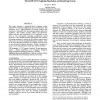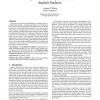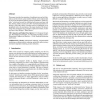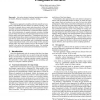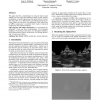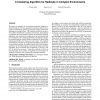111
click to vote
SIGGRAPH
1994
ACM
15 years 5 months ago
1994
ACM
This paper describes a physically-based rendering system tailored to the demands of lighting design and architecture. The simulation uses a light-backwards ray-tracing method with...
106
click to vote
SIGGRAPH
1994
ACM
15 years 5 months ago
1994
ACM
We present an interactive system for creating pen-and-ink illustrations. The system uses stroke textures--collections of strokes arranged in different patterns--to generate textur...
SIGGRAPH
1994
ACM
15 years 5 months ago
1994
ACM
We present a new particle-based approach to sampling and controlling implicit surfaces. A simple constraint locks a set of particles onto a surface while the particles and the sur...
SIGGRAPH
1994
ACM
15 years 5 months ago
1994
ACM
This paper describes the principles of traditional pen-and-ink illustration, and shows how a great number of them can be implemented as part of an automated rendering system. It i...
SIGGRAPH
1994
ACM
15 years 5 months ago
1994
ACM
112
click to vote
SIGGRAPH
1994
ACM
15 years 5 months ago
1994
ACM
This paper describes a methodology for using the matrix-vector multiply and scan conversion hardware present in many graphics workstations to rapidly approximate the optical flow ...
122
click to vote
SIGGRAPH
1994
ACM
15 years 5 months ago
1994
ACM
Range imaging offers an inexpensive and accurate means for digitizing the shape of three-dimensional objects. Because most objects self occlude, no single range image suffices to ...
SIGGRAPH
1994
ACM
15 years 5 months ago
1994
ACM
120
click to vote
SIGGRAPH
1994
ACM
15 years 5 months ago
1994
ACM
We present an approach for accelerating hierarchical radiosity by clustering objects. Previous approaches constructed effective hierarchies by subdividing surfaces, but could not ...
127
click to vote
SIGGRAPH
1994
ACM
15 years 5 months ago
1994
ACM
This paper describes a novel system for creating virtual creatures that move and behave in simulated three-dimensional physical worlds. The morphologies of creatures and the neura...
